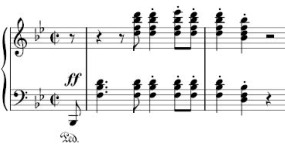From the school‘s library I checked out again the copy of Messiaen’s Le merle noir (The Blackbird) that I used last fall when I played the piece with Paula Robison. Since then, many markings were made in the piano part. I don’t mark anything in the scores I use, but when I opened the music again there were all the things pianists write: dark circles drawn around printed dynamic markings, fingering, penciled-in lines showing correspondences between rhythmic details in the flute part and the music for piano…
In the coda, several notes in piano part had been “redistributed” — scratched out of the music written for the left hand and added to the right-hand part, and vice versa. Some pianists redistribute habitually, to make things easier, or take a note with their right hand if a wide left-hand stretch is unreachable without breaking. There may be questions about how specifically composers intend, or notate, piano music for one hand or the other (or how much we may want to grant them such authority)?
 Certain difficulties in Beethoven’s piano sonatas cause long discussion: the opening diminished-seventh octaves in Opus 111, the first treacherous left-hand jump in the “Hammerklavier.” Jacob Lateiner insists that the notation of passages like the hilarious dive into the lower register in the first movement of Beethoven’s Opus 54 (measure 38) shows the composer’s awareness and authorial command regarding which hand is to play which notes. (The right-hand notes are all written with stems going up in this passage in Opus 54.)
Certain difficulties in Beethoven’s piano sonatas cause long discussion: the opening diminished-seventh octaves in Opus 111, the first treacherous left-hand jump in the “Hammerklavier.” Jacob Lateiner insists that the notation of passages like the hilarious dive into the lower register in the first movement of Beethoven’s Opus 54 (measure 38) shows the composer’s awareness and authorial command regarding which hand is to play which notes. (The right-hand notes are all written with stems going up in this passage in Opus 54.)
Some piano composers care. Others may care less. And some pianists redistribute a lot, others resist. Alfred Cortot apparently played Ravel’s Left-hand Concerto with two hands! Abbey Simon finds intricate redistributive solutions. Some players will redistribute a C-Major scale.
Before a performance of the “Hammerklavier”, Lee Luvisi was struck with fear contemplating Rudolf Serkin’s presence in the audience. He says: “In all my previous performances of the sonata I’d played the opening with two hands… I hadn’t wanted to make a mess of it at the very beginning. Moments before going onstage I had a fit of conscience. ‘My god, Serkin’s sitting there, if he sees me play that with two hands, he’ll never forgive me. He won’t speak to me the rest of my life.’ I had never even practiced it with one hand. But, I knew, it had to be all or nothing.”
I asked Milton Babbitt about difficult-to-play jumps in register that occur in his piano music. It doesn’t matter which hand is used, he said. The continuing question: Is musical notation a set of instructions or a map of what is to be heard? Of course, it’s both, in varying and shifting proportions. For Babbitt, it seems it’s the result that matters, not the means. (Or, that the result would not be affected by the means.) In other pieces, the route is critical.
In Messiaen’s Merle noir, in the coda, the piano part is hard. If all the notes written on the upper staff are played with the right hand and all the lower-staff notes played with the left hand, then there’s constant hand-crossing and overlapping. I practiced it. The result is not absolute tonal equality. Some notes protrude, others are subdued. It’s a constantly shifting avian chiaroscuro of sound.

For Merle Noir (for everything?), absolutely, redistribute at your peril!
The colors, as you mention … also the RHYTHM is lit from within by the effort.
Beethoven does make life difficult at times, like with the first right hand outburst in his Appassionata sonata.
When possible and sparingly, I’m a fan of redistributing the hands in order to ease a hard passage.
Thanks for your intersting article.
When we redistribute the hands, it must make sense musically, as to not take away from the original intention. The intensity must remain as if the one hand did what it was intended, otherwise, if it sounds too easy, it diminishes the musical effect. In purely running and mulit-note passages where redistribution works, absolutely do so. In the case of the ‘Hammerklavier’, the big leap has a space in itself, so the one hand should work. It is the beginning of the mammoth sonata and the majesty of it all would be trivial if one used two hands to get to the LH chord too quickly. Visually, one hand retains that majesty. Then again, with the same space of time for the leap from the low note to the chord, using the right hand on the low B-flat could look very effective. On a recording, though, think about the sound and space of sound you want to create the opening statement. Maybe Beethoven didn’t want it to sound like you got to the chord so quickly using two hands. I would try both ways and base my decision on musical results.
The most effective method of playing the notes varies from one performer and that performer’s hands to another. Determine as best you can what the composer’s ear wants to hear when the decisions regarding distribution were made. Then recreate the same emphases with an easier distribution of notes, fingering, etc. The same principle is effective when dealing with the con-torsions sometimes encountered in the Schnabel edition of the Beethoven Sonatas.